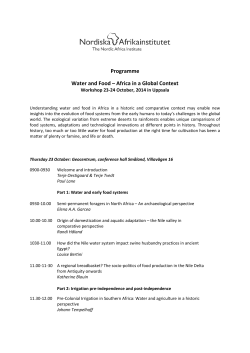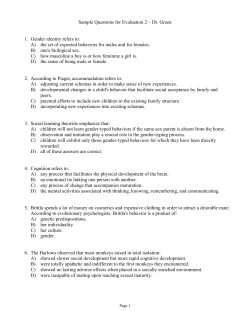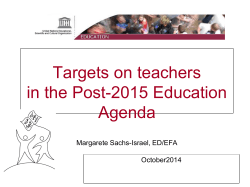
CGE MODEL WITH FORWARD LOOKING EXPECTATIONS FOR CLIMATE CHANGE ADAPTATION EDIP-DP
23/10/2014 CGE MODEL WITH FORWARD LOOKING EXPECTATIONS FOR CLIMATE CHANGE ADAPTATION EDIP-DP ToPDad = tools & model for adaptation research EU FP7 project coordinated by VTT Main objective: developing the next-generation tool set for adaptation research Focus areas: energy, tourism and transport Methodologies: macro-econometric, CGE modelling, transport network modelling & bottom-up investment analysis TRB Workshop on climate change 1 23/10/2014 Modeling impact of climate change • • • • • • • • Many models were developed in the last decades Recursive or comparative dynamic CGE models with focus on mitigation – ETS schemes, energy taxes, investments in ‘clean’ fuels & technology: GEM-E-3, EPPA, GTAP Dynamic CGE models, based on optimal investment strategy: DICE, RICE Adaptation? =Relatively new field of research with added complexity Uncertainty on climate change impact and related damages + impact of adaptation technology Extension of DICE model: De Bruin K. et al (2009) Examples using input-output methodology ARIO model: Hallegatte S. et al (2011) Generally: models are not really equipped for modeling adaptation TRB Workshop on climate change °C Infrastructure with long lifetimes will experience the climate conditions of 2030, 2050 and even 2100 In transport Signaling ~ 3-10 year Rolling stock ~ 30 years Highways ~ 30 – 50 years Waterway / Canals ~ +100 years Damages Resilience Lifetime 2020 2050 2100 TRB Workshop on climate change 2 23/10/2014 What is your adaptation plan? TRB Workshop on climate change EDIP • • • • • • • • EDIP = Economic model for analyzing the impact of EU policy on Distribution of Income and Poverty Computable general equilibrium model of 31 EU countries, based on National account data & input-output data Model integrates 59 sectors, based on NACE v2 Implemented in GAMS software Data was recently updated, following outputs from other projects such as ExioPoll and WIOD Model has a detailed transport sector EDIP can be coupled to the TREMOVE demand & emissions module for transport Applied in a number of EU FP7 projects: REFIT, IceWin, NEUJOBS and now in ToPDad TRB Workshop on climate change 3 23/10/2014 Methodology • • • • 1) Develop a module for optimal investment in adaptation applying the general ideas presented in the previous slides 2) Link the optimal investment module to the main CGE model 3) Apply a test case – assuming long-term climate damages for the transport sector 4) Compare results of ‘Optimal’ – ‘No’ and ‘Reactive’ Adaptation TRB Workshop on climate change Modeling an adaptation response (1) Long term utility (U), represented by intertemporal iso-elasticity function, with consumption ( ), discount rate (0 < < 1), intertemporal elasticity of substitution ( > 0) until a time horizon (T). = 1− (1) We assume that there is a production sector using capital and labour as inputs (K & L), represented by a Constant Elasticity of Substitution (CES) function. , = . / . + (1 − ) / . (2) Capital is subject to depreciation and investments ( ) are necessary for the capital stock to grow. At the same time, capital may experience random shocks ( ). = 1− + + (3) TRB Workshop on climate change 4 23/10/2014 Modeling an adaptation response (2) The investor can freely choose between both types of stocks, with a parameter for measuring the efficiency of capital stock = + (4) The adapted asset has a lower vulnerability for damages due to extreme events ( ). We assume that possible damages are equal to ( . ), with −1 < < 0 and 0 ≤ ≤ 1 When When is equal to 0, the adapted stock provides perfect protection. ≤ , the long term efficiency of the ‘adapted’ asset is lower than the vulnerable one = 1+ & ≥ = >0 1+ (8) TRB Workshop on climate change Perfect adaptation to known shock 1 2 3 4 1 2 3 4 Deceleration Acceleration Shock Adjustment +- no deviation from long term capital stock Adaptation decreases after shock TRB Workshop on climate change 5 23/10/2014 Reactive adaptation Initial shock is 50% and takes place in period t=10. The expectation for future damages is equal to 20% of the initial shock (10%). In the next period the expectation decreases to 90% of the previous period’s expectation. This continues for each period without a shock. TRB Workshop on climate change Combined response (expected + reactive) TRB Workshop on climate change 6 23/10/2014 Linking optimal investment module to EDIP Calibrate static version of EDIP model Calibrate perfect foresight model Choose and apply climate change scenario Long term growth rate by economic sector Capital cost, rate of innovation, discount rate Hazard rate, damage intensity, climate Dynamic reference scenario of EDIP Run dynamic model with perfect foresight Choose active sectors, growth scenario Share of adapted stock, given expected damage Stochastic simulation of shocks Run sequential model, including adapted stock and stochastic shocks TRB Workshop on climate change , EDIP Dynadapt , ∗ , The desired level of investments in the EDIP model, can be derived from the desired capital stock in the next period ∗ . This means that in EDIP, investments in period t ( ) are equal to (with s indicating sectors). , = ∗ , − 1− , . Investments in stock are linked in EDIP to savings, such that , = − − + + TRB Workshop on climate change 7 23/10/2014 Results in a dynamic program with optimal investments (Ramsey type) 3.5 Temperature profile until 2100 Θ=0.1 (hazard rate) Ω=0.2 (damage inflation) D0 = 5% T* = 0.8 (hazard T) T**= 1.5 (damage T) 3 Degree of warming 2.5 2 Δ= 0.05 (depreciation) μ= 0/0.2 (price adapt) 1.5 1 0.5 0 2000 2020 2040 2060 2080 2100 2120 TRB Workshop on climate change Simulation with EDIP-DP • • • Problem: Damages happen at discrete and unforeseen points in time > no smooth curve as in the pictures above Solution: Simulate a dynamic non-homogeneous Poisson process that uses the calculated probabilities as inputs and outputs discrete ‘disturbances’ EDIP models the full macro-economic impacts TRB Workshop on climate change 8 23/10/2014 Actual shocks derived from heterogeneous Poisson process (stochastic draw) TRB Workshop on climate change Investment 1.025 Expected damages (in % of stock) 1.02 0.014 1.015 0.012 1.01 1.005 0.01 1 0.008 0.995 0.006 0.99 0.985 0.004 0.98 0.002 0.975 0.97 2010 2030 2050 2070 0 2010 2090 Total adapted stock (%) 2030 0.9 2070 2090 Capital stock 1.002 1 2050 1 0.8 0.7 0.998 0.6 0.5 0.996 0.4 0.994 0.3 0.2 0.992 0.1 0 2010 2030 2050 2070 2090 0.99 2010 2030 2050 2070 2090 TRB Workshop on climate change 9 23/10/2014 TRB Workshop on climate change Disaggregated impact of shock on GDP Impact of shock TRB Workshop on climate change 10 23/10/2014 THANK YOU! Questions? TRB Workshop on climate change 11
© Copyright 2025











